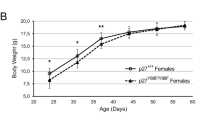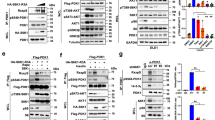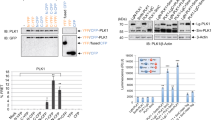Abstract
p21-activated kinase 1 (PAK1) is a mediator of downstream signaling from the small GTPases Rac and Cdc42. In its inactive state, PAK1 forms a homodimer where two kinases inhibit each other in trans. The kinase inhibitory domain (KID) of one molecule of PAK1 binds to the kinase domain of its counterpart and keeps it inactive. Therefore, the isolated KID of PAK1 has been widely used to specifically inhibit and study PAK function. Here, we show that the isolated KID induced a cell cycle arrest with accumulation of cells in the G1 phase of the cell cycle with an inhibition of cyclin D1 and D2 expression. This cell cycle arrest required the intact KID and was also induced by a mutated KID unable to block PAK1 kinase activity. Furthermore, the KID-induced cell cycle arrest could not be rescued by the expression of a constitutively active PAK1-T423E mutant, concluding that this arrest occurs independently of PAK1 kinase activity. Our results suggest that PAK1 through its KID inhibits cyclin D expression and thereby enforces a cell cycle arrest. Our results also call for serious precaution in the use of KID to study PAK function.
This is a preview of subscription content, access via your institution
Access options
Subscribe to this journal
Receive 50 print issues and online access
$259.00 per year
only $5.18 per issue
Buy this article
- Purchase on Springer Link
- Instant access to full article PDF
Prices may be subject to local taxes which are calculated during checkout




Similar content being viewed by others
References
Adam L, Vadlamudi R, Mandal M, Chernoff J, Kumar R . (2000). Regulation of microfilament reorganization and invasiveness of breast cancer cells by kinase dead p21-activated kinase-1. J Biol Chem 275: 12041–12050.
Bakhiet M, Tjernlund A, Mousa A, Gad A, Stromblad S, Kuziel WA et al. (2001). RANTES promotes growth and survival of human first-trimester forebrain astrocytes. Nat Cell Biol 3: 150–157.
Balasenthil S, Sahin AA, Barnes CJ, Wang RA, Pestell RG, Vadlamudi RK et al. (2004). p21-activated kinase-1 signaling mediates cyclin D1 expression in mammary epithelial and cancer cells. J Biol Chem 279: 1422–1428.
Bartek J, Lukas J, Bartkova J . (1999). Perspective: defects in cell cycle control and cancer. J Pathol 187: 95–99.
Bekri S, Adelaide J, Merscher S, Grosgeorge J, Caroli-Bosc F, Perucca-Lostanlen D et al. (1997). Detailed map of a region commonly amplified at 11q13 – >q14 in human breast carcinoma. Cytogenet Cell Genet 79: 125–131.
Bokoch GM, Wang Y, Bohl BP, Sells MA, Quilliam LA, Knaus UG . (1996). Interaction of the Nck adapter protein with p21-activated kinase (PAK1). J Biol Chem 271: 25746–25749.
Brown JL, Stowers L, Baer M, Trejo J, Coughlin S, Chant J . (1996). Human Ste20 homologue hPAK1 links GTPases to the JNK MAP kinase pathway. Curr Biol 6: 598–605.
Chi S, Chang S, Park D . (2004). Pak regulates calpain-dependent degradation of E3b1. Biochem Biophys Res Commun 319: 683–689.
Chong C, Tan L, Lim L, Manser E . (2001). The mechanism of PAK activation. Autophosphorylation events in both regulatory and kinase domains control activity. J Biol Chem 276: 17347–17353.
Cvrckova F, De Virgilio C, Manser E, Pringle JR, Nasmyth K . (1995). Ste20-like protein kinases are required for normal localization of cell growth and for cytokinesis in budding yeast. Genes Dev 9: 1817–1830.
Dadke D, Fryer BH, Golemis EA, Field J . (2003). Activation of p21-activated kinase 1-nuclear factor kappaB signaling by Kaposi's sarcoma-associated herpes virus G protein-coupled receptor during cellular transformation. Cancer Res 63: 8837–8847.
DerMardirossian C, Schnelzer A, Bokoch GM . (2004). Phosphorylation of RhoGDI by Pak1 mediates dissociation of Rac. GTPase Mol Cell 15: 117–127.
Galisteo ML, Chernoff J, Su YC, Skolnik EY, Schlessinger J . (1996). The adaptor protein Nck links receptor tyrosine kinases with the serine-threonine kinase. Pakl J Biol Chem 271: 20997–21000.
Holly SP, Blumer KJ . (1999). PAK-family kinases regulate cell and actin polarization throughout the cell cycle of Saccharomyces cerevisiae. J Cell Biol 147: 845–856.
Jaffer ZM, Chernoff J . (2002). p21-activated kinases: three more join the Pak. Int J Biochem Cell Biol 34: 713–717.
Lee SH, Eom M, Lee SJ, Kim S, Park HJ, Park D . (2001). BetaPix-enhanced p38 activation by Cdc42/Rac/PAK/MKK3/6-mediated pathway. Implication in the regulation of membrane ruffling. J Biol Chem 276: 25066–25072.
Lei M, Lu W, Meng W, Parrini MC, Eck MJ, Mayer BJ et al. (2000). Structure of PAK1 in an autoinhibited conformation reveals a multistage activation switch. Cell 102: 387–397.
Leisner TM, Liu M, Jaffer ZM, Chernoff J, Parise LV . (2005). Essential role of CIB1 in regulating PAK1 activation and cell migration. J Cell Biol 170: 465–476.
Li F, Adam L, Vadlamudi RK, Zhou H, Sen S, Chernoff J et al. (2002). p21-activated kinase 1 interacts with and phosphorylates histone H3 in breast cancer cells. EMBO Rep 3: 767–773.
Li W, Chong H, Guan KL . (2001). Function of the Rho family GTPases in Ras-stimulated Raf activation. J Biol Chem 276: 34728–34737.
Li Z, Hannigan M, Mo Z, Liu B, Lu W, Wu Y et al. (2003). Directional sensing requires G beta gamma-mediated PAK1 and PIX alpha-dependent activation of Cdc42. Cell 114: 215–227.
Manser E, Huang HY, Loo TH, Chen XQ, Dong JM, Leung T et al. (1997). Expression of constitutively active alpha-PAK reveals effects of the kinase on actin and focal complexes. Mol Cell Biol 17: 1129–1143.
Manser E, Leung T, Salihuddin H, Zhao ZS, Lim L . (1994). A brain serine/threonine protein kinase activated by Cdc42 and Rac1. Nature 367: 40–46.
Manser E, Loo TH, Koh CG, Zhao ZS, Chen XQ, Tan L et al. (1998). PAK kinases are directly coupled to the PIX family of nucleotide exchange factors. Mol Cell 1: 183–192.
Nheu T, He H, Hirokawa Y, Walker F, Wood J, Maruta H . (2004). PAK is essential for RAS-induced upregulation of cyclin D1 during the G1 to S transition. Cell Cycle 3: 71–74.
Parrini MC, Lei M, Harrison SC, Mayer BJ . (2002). Pak1 kinase homodimers are autoinhibited in trans and dissociated upon activation by Cdc42 and Rac1. Mol Cell 9: 73–83.
Resnitzky D, Gossen M, Bujard H, Reed SI . (1994). Acceleration of the G1/S phase transition by expression of cyclins D1 and E with an inducible system. Mol Cell Biol 14: 1669–1679.
Schraml P, Schwerdtfeger G, Burkhalter F, Raggi A, Schmidt D, Ruffalo T et al (2003). Combined array comparative genomic hybridization and tissue microarray analysis suggest PAK1 at 11q13.5-q14 as a critical oncogene target in ovarian carcinoma. Am J Pathol 163: 985–992.
Sells MA, Boyd JT, Chernoff J . (1999). p21-activated kinase 1 (Pak1) regulates cell motility in mammalian fibroblasts. J Cell Biol 145: 837–849.
Sells MA, Knaus UG, Bagrodia S, Ambrose DM, Bokoch GM, Chernoff J . (1997). Human p21-activated kinase (Pak1) regulates actin organization in mammalian cells. Curr Biol 7: 202–210.
Shockett P, Difilippantonio M, Hellman N, Schatz DG . (1995). A modified tetracycline-regulated system provides autoregulatory, inducible gene expression in cultured cells and transgenic mice. Proc Natl Acad Sci USA 92: 6522–6526.
Sundberg-Smith LJ, Doherty JT, Mack CP, Taylor JM . (2005). Adhesion stimulates direct PAK1/ERK2 association and leads to ERK-dependent PAK1 Thr212 phosphorylation. J Biol Chem 280: 2055–2064.
Tang Y, Chen Z, Ambrose D, Liu J, Gibbs JB, Chernoff J et al. (1997). Kinase-deficient Pak1 mutants inhibit Ras transformation of Rat-1 fibroblasts. Mol Cell Biol 17: 4454–4464.
Thiel DA, Reeder MK, Pfaff A, Coleman TR, Sells MA, Chernoff J . (2002). Cell cycle-regulated phosphorylation of p21-activated kinase 1. Curr Biol 12: 1227–1232.
Thullberg M, Bartek J, Lukas J . (2000). Ubiquitin/proteasome-mediated degradation of p19INK4d determines its periodic expression during the cell cycle. Oncogene 19: 2870–2876.
Vadlamudi RK, Adam L, Wang RA, Mandal M, Nguyen D, Sahin A et al. (2000). Regulatable expression of p21-activated kinase-1 promotes anchorage-independent growth and abnormal organization of mitotic spindles in human epithelial breast cancer cells. J Biol Chem 275: 36238–36244.
Weiss EL, Bishop AC, Shokat KM, Drubin DG . (2000). Chemical genetic analysis of the budding-yeast p21-activated kinase Cla4p. Nat Cell Biol 2: 677–685.
Welsh CF, Roovers K, Villanueva J, Liu Y, Schwartz MA, Assoian RK . (2001). Timing of cyclin D1 expression within G1 phase is controlled by Rho. Nat Cell Biol 3: 950–957.
Zenke FT, King CC, Bohl BP, Bokoch GM . (1999). Identification of a central phosphorylation site in p21-activated kinase regulating autoinhibition and kinase activity. J Biol Chem 274: 32565–32573.
Zhao ZS, Lim JP, Ng YW, Lim L, Manser E . (2005). The GIT-Associated Kinase PAK Targets to the Centrosome and Regulates Aurora-A. Mol Cell 20: 237–249.
Zhao ZS, Manser E, Chen XQ, Chong C, Leung T, Lim L . (1998). A conserved negative regulatory region in alphaPAK: inhibition of PAK kinases reveals their morphological roles downstream of Cdc42 and Rac1. Mol Cell Biol 18: 2153–2163.
Acknowledgements
We thank Dr Edward Manser for kindly providing the pXJGST-KID and pXJGSTKID-L107F constructs and the Developmental Studies Hybridoma Bank, University of Iowa for providing anti-BrdU mab G3G4 and anti-myc mab 9E10. This work was supported by grants to SS from the Swedish Cancer Society and the Swedish Research Council and to MT from The Swedish Society of Medicine. SS holds a senior scientist position from the Swedish Research Council and MT was supported from The Swedish Cancer Society and The Swedish Society of Medicine. AB and JC were supported by grants from the National Institutes of Health.
Author information
Authors and Affiliations
Corresponding author
Rights and permissions
About this article
Cite this article
Thullberg, M., Gad, A., Beeser, A. et al. The kinase-inhibitory domain of p21-activated kinase 1 (PAK1) inhibits cell cycle progression independent of PAK1 kinase activity. Oncogene 26, 1820–1828 (2007). https://doi.org/10.1038/sj.onc.1209983
Received:
Revised:
Accepted:
Published:
Issue Date:
DOI: https://doi.org/10.1038/sj.onc.1209983
Keywords
This article is cited by
-
Group I Paks are essential for epithelial- mesenchymal transition in an Apc-driven model of colorectal cancer
Nature Communications (2018)
-
Effect of PAK1 gene silencing on proliferation and apoptosis in hepatocellular carcinoma cell lines MHCC97-H and HepG2 and cells in xenograft tumor
Gene Therapy (2018)
-
PAK1 regulates cortical development via promoting neuronal migration and progenitor cell proliferation
Molecular Brain (2015)
-
PAK signalling during the development and progression of cancer
Nature Reviews Cancer (2014)
-
Group I p21-activated kinases facilitate Tax-mediated transcriptional activation of the human T-cell leukemia virus type 1 long terminal repeats
Retrovirology (2013)



